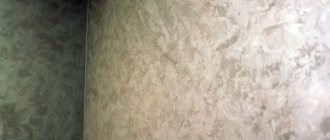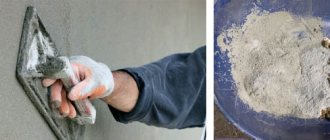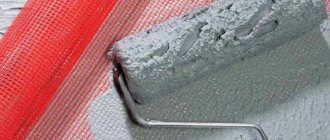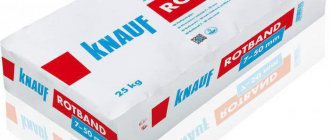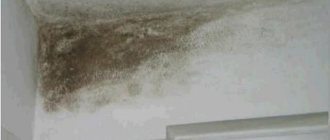In any repair, accuracy and quality of work are important. Much attention is always paid not only to a beautiful finish, but also to a flat floor, smooth walls, and an ideal ceiling. In capital construction, walls sometimes deviate from the vertical axis; they have relief, irregularities or bends. In such cases, the walls are leveled before finishing. A simple and popular option for performing this process is to align the walls along the beacons. If the work is done correctly, the surface will be smooth, and it will be easy to perform any finishing and decor on it. The work requires specialized tools, but the process itself is quite simple, and it can be done without the help of professionals by studying some theoretical material. But is it necessary to remove the beacons after plastering the walls?
This question remains one of the controversial ones; experienced builders are divided into two groups: the first believe that removing beacons after plastering is necessary, others believe that this is just a waste of time. The final choice depends on the technical recommendations for specific slats, the location of their installation and the intended decor.
What are they used for?
Beacons for leveling walls are a simple device consisting of galvanized metal slats. If you cut a profile crosswise, this tool resembles the letter “T”. The process is performed relative to the top edge of the profile. The “leg” of the beacon is designed to securely fix it on the work surface. The tool is placed strictly vertically on the wall.
Beacons are used to improve the quality of wall alignment. The mass is stretched relative to the installed slats using a rule, and a perfectly even coating is obtained. Their use is convenient because their installation does not require deep knowledge in the construction industry. There are four main types of leveling slats: metal strip, metal pipe, plaster or cement beacons, corner beacons. Each type has its pros and cons and is preferable in some cases.
Beacons are used to improve the quality of wall alignment.
Can they be reused?
Some thrifty DIYers ask whether used lighthouse markers can be re-installed. If they are made of metal pipes or durable rolled metal, then it is possible, because such material is not subject to deformation. But most often beacons are profiles made of thin sheet metal. When you pull them out of the wall, they change their shape, break, and bend. Therefore, all that remains is to dispose of them. When creating a perfectly flat surface, beacon strips must be solid and even guides along which the rule glides easily.
Whether it is necessary to remove the lighthouse landmarks from the plaster is the choice of the master. But it’s better to be sure that nothing will damage the finish than to make repairs after a while due to the fact that the beacons were not removed from the wall or ceiling covering in time.
Source
Why remove beacons from plaster
To understand whether it is necessary to remove the beacons from the wall after plastering, it is necessary to note the following significant factors:
- If the material from which the beacons are made is prone to rust, the pigment can break through the finish and spoil the appearance. Such a defect may appear due to poor quality of the material, too high level of humidity in the room, mechanical damage to the anti-corrosion layer during installation of the beacons (usually during leveling or sandpaper during grinding) or its complete absence. The appearance of a characteristic color will not take long to appear if the final covering is made of wallpaper or a layer of paint is applied;
- The slats may move away from the surface being treated, which will cause detachments and cracks in the material. It will become deformed and fall off. Poor fastening of the slats to the wall may depend on the distance between the screws fixing it, strong vibration of the walls, or shrinkage of the plaster mixture, accompanied by loss of its properties;
- If you plan to install hanging furniture, the fasteners may damage the planks, which will affect the quality of the plaster coating. When a hammer touches metal, vibration occurs, which can cause cracks and detachments to appear.
Laths embedded in hardened plaster do not have any beneficial properties and can only damage the coating. Most experienced plasterers are inclined to take out the beacons after plastering. But some see positive features in leaving the slats mounted in the wall: significant savings in time resources and building materials, since there is no need to fill the resulting holes with plaster.
Laths embedded in hardened plaster do not have any beneficial properties and can only damage the coating.
After plastering the walls, do you need to remove the beacons or can you leave them?
Beacons help reduce solution consumption and level the base of the wall. There are several types of profiles on the market, each of which has its own advantages and disadvantages. To make the right choice, you should familiarize yourself with the characteristics of each product.
Factory types and their purpose
The length of standard perforated guides can vary from 2.6 to 7 m.
Various materials can be used in production:
- aluminum;
- Cink Steel;
- plastic.
Metal products are the most common.
The demand for these beacons is due to many advantages:
- relatively inexpensive price;
- simple and convenient installation;
- slats are available in various sizes;
- strength of the material.
The size of the product can be adjusted using special scissors.
Metal beacons also have disadvantages:
- Capable of deformation (due to insufficient rigidity).
- Non-professionals may have difficulties during installation.
- After finishing work is completed, the beacons should be removed. If this stage of work is ignored, then over time rust may form on the decorative coatings.
Plastic beacons are less in demand for decoration (as opposed to metal products).
Material Features:
- Easy installation. Plastic is easy to work with (even for an inexperienced craftsman).
- A light weight. Thanks to this, installation is less labor-intensive.
- The elements retain their original shape well. After deformation, the plastic part regains its original appearance.
- Unpretentiousness of the material. Plastic does not undergo oxidation and corrosion, which prevents the formation of rust and dark spots on the walls.
Despite many advantages, plastic products also have weaknesses:
- The profiles are only suitable for interior decoration. They cannot be used for external cladding, because... At low temperatures the material may break.
- Low strength and wear resistance. The products cannot withstand impacts and heavy loads.
- If installed incorrectly, the parts may bend, which will lead to deformation of the base.
Often galvanized beacons (made of stainless steel) are used for finishing.
Main advantages of the products:
- High strength. The beacons are not deformed and wear-resistant.
- The parts can be reused multiple times.
- Increased rigidity.
The disadvantage of the product is the high price. There are also products on sale without galvanization, which quickly rust.
The use of homemade beacons
Instead of factory profiles, you can use homemade products. They are made from various materials. They are inexpensive and at the same time easy to use.
There are several options:
- Wooden slats. Most often, the products are used for finishing wooden foundations. They are fixed to the surface using self-tapping screws.
- Gypsum beacons. Such guides are not removed after plastering (this helps reduce work time).
- String beacons. Installation requires screws, wire (or fishing line) and a hammer drill. Using the latter, holes are made in the wall and dowels are inserted into them. After this, the wire or fishing line is pulled. The distance from the guide is filled with solution. After the mixture has dried, the material and other fasteners are removed.
Disadvantages of string beacons:
- Inaccurate placement of screws can negatively affect the evenness of the surface.
- Improper removal of the plaster layer can lead to curvature of the foundation.
- Any bending of the string will negatively affect the quality of the work performed.
- Complicated installation process.
In what cases should you not remove beacons?
Beacons can be left in the plaster if tiling, tile or stone laying is done. Beacons do not need to be removed after plastering the walls, unless the formation of rust and the development of pigment will affect the appearance of the work.
There is no need to remove the beacons after plastering the walls if the profiles are made of high-quality material using modern technologies.
It is better to buy all repair materials from large chain stores with a quality certificate attached. If you decide to leave the beacons in the wall, you should avoid significantly increasing the humidity in the room. You can also mark the locations of the slats so that when using a hammer drill or driving nails, you can avoid contact with the metal. In addition, the outer parts of the profiles (sliding ribs) can be coated with a solution that prevents metal corrosion, but an unambiguous result after this procedure cannot be guaranteed.
Manufacturers of such compositions recommend renewing the coating from time to time, which is impossible in the case of metal slats, and not every such paint will function safely under conditions of complete insulation in cement.
Beacons do not need to be removed after plastering the walls, unless the formation of rust and the development of pigment will affect the appearance of the work.
Appearance of rust
Often low-quality material begins to rust. The main reason for the appearance of this disease is the low-quality material of the lighthouses themselves, from which they are made.
In most cases, people try to save on everything, including building materials, so they purchase raw materials from unverified suppliers in small retail outlets. The latter, in turn, in order to get more profit, offer products made from low-quality raw materials and pass them off as a well-known brand. It is unlikely that you will be able to return the products, since you will not get a guarantee for this type of goods from them, as well as probably a sales receipt.
The next reason for the formation of rust may be excessive load on the lighthouse itself during plastering of the walls. The leveling part of the rule rubs against the beacon more than once; the outer layer gradually collapses, exposing the internal structure.
The main reasons may be high humidity, lack of heating of the area, and non-functioning natural ventilation of the room.
Removal technology
Before removing the beacons after plastering, you need to determine how hard the plaster has hardened. It is easiest to remove beacons from uncured material after plastering, and if the coating has already dried, it is necessary to resort to special methods for removing them. If you decide that you need to pull out the beacons after plastering, you need to purchase some tools:
- Pliers;
- Chisel – a steel tool (scraper) for working with plaster;
- Stepladder or sturdy table;
- Magnet (if the walls are already puttied);
- Coarse sandpaper.
The technology for removing beacons after plastering is almost always the same. The beacons must be removed after plastering in such a way as to cause minimal damage to the finished coating. If the material has not yet completely hardened, you should make cuts along the edges of the profile using a spatula and clean it as much as possible from the plaster. The next day, the slats are easily removed by screwing them onto a screwdriver, and the resulting openings are filled with material and sanded with sandpaper.
The beacons must be removed after plastering in such a way as to cause minimal damage to the finished coating.
If the decision to remove the slats was made after the plaster had completely hardened, the work is performed according to this algorithm:
- Using a magnet, the places from which the slats will be removed are determined. This step can be skipped if, when marking, marks were left on the ceiling of the room corresponding to the location of the beacons.
- Under the ceiling, using a chisel, remove the top layer of plaster and putty in place of the lath.
- Using a chisel, carefully bend the upper edge of the profile. At this stage, you need to avoid the appearance of cracks in the wall.
- Using pliers, the strip is unscrewed and completely removed from the wall surface. Beacons must be removed from plaster with careful, smooth movements, otherwise large defects or material detachments may form in the plaster layer.
- Beacons should be removed after plastering in small pieces 10-15 cm long
- The holes formed after removing the beacons after plastering the walls must be removed - plastered with the same composition that was applied to the main part of the wall.
The holes formed after removing the beacons after plastering the walls must be removed.
Beacon installation
The quality of the finish depends on the correct installation of the beacons. First of all, install the outer beacons on different sides of the wall, usually at a distance of 10-20 cm from the corner.
The installation surface should be treated with water or primer. They should be installed perfectly and exactly level. The quality of the plastered surface will depend mainly on the correct installation of these beacons. If there are depressions on the wall, then the outermost beacons must be recessed into the wall. Thus, it will be possible to reduce the thickness of the plaster layer. If you find a bulge, then it should be removed using a hammer and chisel or a hammer drill with an attachment.
Then, at two different horizontal levels, an extremely stretched thread is attached to them, along which the remaining intermediate beacons are set in increments of 50-80 cm.
It is better to carry out installation work together, as this will simplify the task and increase the quality of their installation.
What to do with beacons later
Most often, slats are used only once. Since the beacons need to be pulled out after plastering the walls in small pieces 10-15 cm long, the tool is not suitable for further use. If small pieces were removed without bending or any mechanical damage, they can be reused by installing them on narrow sections of the wall, for example, above a doorway.
Many developed chains of construction stores offer a large selection of tools and materials, including all kinds of corrective profiles for leveling walls. Both the process of installing and removing metal slats is actually not as complicated as it might seem at first glance. However, to perform the work competently, you need to have at least a little experience in the construction industry, study some theoretical material and note important details. Before removing the beacons after plastering the walls, you need to draw up an algorithm of actions and highlight points for each stage. Next, confidently begin the practical part.
Most often, slats are used only once.
So, is it necessary to remove beacons after plastering? The decision depends on the intended finish of the wall: if tiles, tiles or decorative stone are installed, there is no need to remove the slats. Most experienced repairmen believe that it is necessary to remove beacons after plastering the walls in order to avoid the appearance of internal and external defects.
Is there any benefit from beacons in finished plaster?
Some craftsmen believe that removing beacons from the wall after leveling is a waste of time and effort. But a small saving of time when saving profiles inside the plaster layer can result in repairs to the coating at the most inopportune moment.
The guides are used to level the walls. After fulfilling the function assigned to them, they turn out to be useless, located in the finished plaster. They can cause damage to the coating if they remain inside, so it is better to remove them to ensure that they do not have a negative effect on the coating and finishing materials.
Appearance of cracks
The reasons for the appearance of cracks can be very diverse.
The first and main reason is the refusal to prime the surface for the beacon. It is important to install it on a flat surface without cracking or internal damage. If you neglect this, you are guaranteed to get a crack. The lighthouse should be screwed to the wall or glued along its entire length. For more information about how walls are plastered using beacons, see this video:
If the distances between the fastenings are made greater than those recommended by experts, then after a long time the lighthouse will begin to move away, cracks and breaks will appear. The main factor behind the separation can be frequent vibrations of the walls and shrinkage of the plaster.
